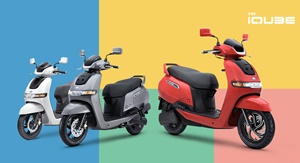TVS group company TVS Scooters is reported to have patented its upcoming hydrogen fuel cell powered iQube scooter, a development that places the Hosur-based two-wheeler maker close to developing an advanced technology product.

Images of the hydrogen fuel cell powered scooter, an adaptation of its recently-launched iQube e-scooter, shows that the company has nearly finished developing the prototype.
The leaked images of the prototype show the chassis downtube at the front has the cannisters that store hydrogen gas. The cannisters are connected to the hydrogen fuel cells stacked under the seat via dedicated pipes that are routed under the floorboard. There is also a regular battery pack, probably a lithium-ion unit, under the floorboard for emergency needs.
The battery pack will get charged by regenerative braking and/or from excess electricity produced by the fuel cells. Almost all components, including the pressure regulator, flow meter, and shut-off valve are in place, showing that the company has nearly finished making the prototype.
The patent image of the scooter does not show a motor, which shows the possibility of a hub motor.
The exterior looks very similar to that of the current iQube while the parts are arranged in a simple manner with maximum focus on serviceability.
Once launched, the hydrogen fuel cell scooter will do away with the need for charging as the hydrogen filled in the cannisters will help produce the required electricity for running the scooter.
Hydrogen fuel cells scooters are similar to battery-operated scooters with the cathode, anode, and electrolyte between them. Hydrogen is supplied to the anode and atmospheric oxygen is supplied to the cathode.
When hydrogen gets in touch with the anode, a catalyst splits its protons and electrons. The electrolyte allows only the protons to swim through it to reach the cathode.
So, the electrons are forced to go through the external wire to reach the cathode which then are trapped as electricity and transferred to the controller and the motor.
When both the protons and electrons reach the cathode, hydrogen and oxygen react to form water vapour which is sent out as exhaust gas. Once this technology gets perfected, the battery electric vehicle technologies will get outmoded.






















